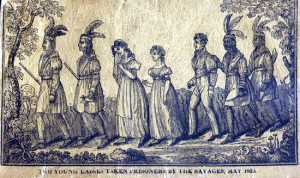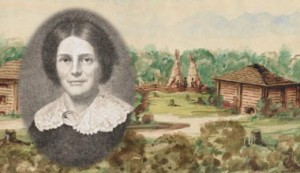Here is the second part of last week’s blog post about Juliette Gordon Low’s maternal relatives. For your summer enjoyment, you might consider a reading Wau-Bun. If you do, write in and let me know what you thought of it–it’s definitely an adventure story!
______________
The women in the Kinzie family were a fascinating lot. How their stories affected the self-image and the sense of possibility for Daisy Gordon Low is worth pondering. Both wives of John Kinzie, Juliette Gordon Low’s great grandfather, shared a most unusual experience. The daughter of the second wife went on to have her own adventures, which she wrote about in Wau-Bun.
According to some accounts, when she was ten years old, Kinzie’s first wife, Margaret McKenzie (b. 1778), was taken captive by Native Americans in Virginia, along with her younger sister Elizabeth. The Shawnee, so this story goes, killed everyone in the family except the two daughters and their father, who managed to escape. The sisters grew up among the Shawnee. When Margaret was twenty she met and was probably ransomed by John Kinzie. She married him in Detroit. Elizabeth also married. At some later point, Margaret’s father located his daughters and both Margaret and Elizabeth soon thereafter took their children and, for reasons unknown, returned with their father to Virginia—leaving the husbands in Detroit. The many possible explanations for their leave taking are, of course, really interesting to ponder.
Kinzie next wed Eleanor Lytle McKillip (1769-1834), the widow of a British army officer and the mother of a young daughter. Eleanor’s childhood also included being held captive by Native Americans. The Seneca chief Cornplanter abducted Eleanor, her two siblings, and their mother. As the family story goes, on the pretext of assisting the exhausted Mrs. Lytle, one of Cornplanter’s men carried her infant for her. But then he swung the baby against a tree and dashed out his brains, killing him. Mrs. Lytle had to be stoic. Cornplanter sent Mrs. Lytle and her other son home, but would not release Eleanor. Chief Cornplanter and his mother were good to the energetic child, whom they called Little Ship Under Full Sail. When they met up with her family again four years later though, Cornplanter saw how Eleanor missed her family, and let her return.
Eleanor and John Kinzie had four children who lived to adulthood, including John Harris Kinzie. John Harris married Juliette Augusta Magill (1806-1870), the daughter of Frances Wolcott and Connecticut banker Arthur Magill. Eleanor may have studied with the famous educator and woman’s rights advocate, Emma Willard. It was through her uncle, Alexander Wolcott, who was the Indian agent in Chicago, that she met John Harris Kinzie. The two married in 1830 and he took up his job as Indian sub-agent in the Michigan territory. Clearly appreciating both worlds, Juliette accompanied him cheerfully, but took with her a piano, her Boston furniture, complete china table settings, and ball gowns. They began a rough life on the edge of civilization as she knew it. You can visit their home in Portage, Wisconsin. In 1834 the Kinzies moved to Chicago. They raised six children, including Eleanor, Daisy’s redoubtable mother.
There is so much more about these women that cannot go in my book—but how remarkable they all were! Little Ship Under Full Sail was a name applied both to Nellie Gordon and to Daisy herself. How much more did they inherit from their foremothers?Juliette Kinzie listened carefully to her relatives and in 1844 published their tales in her Narrative of the Massacre at Chicago, August 15, 1812. Her memoir, Wau-bun, teems with her observations of flora and fauna and ways of living long before the first factory arrived. She wrote of water so clear a dollar coin could be seen sixty feet down and described the inside of Ho-Chunk lodges. Kinzie later published two novels, Walter Ogilby (J.B. Lippincott, 1869) and Mark Logan: The Bourgeois (J.B. Lippincott, 1887), both drawn from her own experiences. Her writings generally treat sympathetically both Native Americans and white settlers.
_____
2012 note: The photo of Juliette Kinzie comes from the Wisconsin Historical Society, which earlier this year hosted a dinner based on traditional foods that she might have eaten. Click HERE to see the menu and to learn more. I think that the archivists and librarians and historians connected with this event are marvelously clever. I take my hat off to you all, and I hope the event was a great success!
(The first photo is from the Abraham Lincoln Historical Digitization Project (http://lincoln.lib.niu.edu/).



